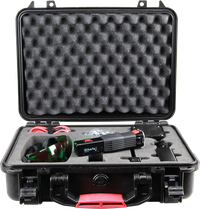
What makes a good laser?
When it comes to laser therapy, understanding the underlying philosophies behind what makes a laser effective can significantly enhance your decision-making process. The laser market is driven by three primary philosophies that each play a critical role in the effectiveness of a laser system: Optimum Energy Delivery, Pulsing for Enhanced Tissue Reaction, and Utilizing Different Wavelengths for Specific Biological Responses.
Factors to Consider
Optimum Energy Delivery (Dosage)
The foundation of effective laser therapy lies in the principle of photobiostimulation, which is all about delivering the optimum energy dose to the target tissue. Dosage, measured in joules, refers to the amount of light energy delivered per unit area (joules/cm²) and is the most critical factor in ensuring successful outcomes in laser therapy.
Why Dosage Matters:
The biological processes that laser therapy aims to stimulate—such as increased cellular energy production, enhanced circulation, and accelerated tissue repair—depend on precise energy delivery. If the dosage is too low, the therapeutic effects may be minimal or nonexistent. Conversely, if the dosage is too high, it can lead to diminished returns, where additional energy does not translate into further therapeutic benefit, and in some cases, may even hinder the healing process.
Tailoring Dosage:
Different conditions require different dosages, which is why understanding the specific needs of the treatment area is crucial. For instance, superficial conditions like skin abrasions or inflammation may require lower dosages, while deeper, more chronic conditions such as joint or muscle injuries necessitate higher energy levels. Proper dosage not only maximizes the efficacy of the treatment but also ensures that therapy is conducted in a time-efficient manner, delivering results without unnecessary prolonged sessions.
Pulsing vs. Continuous Wave
Pulsing involves turning the laser on and off rapidly during treatment, rather than delivering a continuous beam of light. This method introduces an additional variable—frequency, measured in Hertz (Hz)—which can be fine-tuned to enhance the therapeutic effect. The duty cycle, or the percentage of time the laser is actually emitting light during a pulsed session, further refines this process.
Why Pulsing is Important:
Pulsing can enhance tissue response by delivering higher peak energy levels without increasing the average power output, which allows for deeper penetration and more effective stimulation of the target tissue. This is particularly useful in long-term treatment plans, as pulsing helps to prevent the body from becoming desensitized to the therapy. In essence, pulsing can keep the tissue “responsive” and maintain the therapeutic effect over time.
Applications of Pulsing:
The effectiveness of pulsing is highly application-specific. For example, in treating nervous system damage or neurological conditions, continuous wave (CW) lasers, which do not pulse, are often more effective. However, for conditions involving soft tissue repair or pain management, pulsed lasers have shown superior results. Moreover, pulsing can be adjusted to match the specific needs of the patient, such as altering the frequency to target different layers of tissue or to accommodate the chronicity of the condition being treated.
Wavelengths & Application
Wavelength Variety and Their Roles:
Light interacts with biological tissues in highly specific ways depending on its wavelength. The wavelength of a laser, measured in nanometers (nm), determines how deeply the light can penetrate the tissue and which cellular components it will affect. This is because different wavelengths are absorbed by different chromophores (light-sensitive molecules) within the cells.
Key Wavelengths and Their Applications:
800-810nm (Primary Wavelength): Widely recognized as the most effective wavelength for deep tissue therapy, particularly in stimulating the mitochondria—the cell's powerhouse—to increase ATP production. This wavelength is versatile and suitable for treating a wide range of conditions, making it the preferred choice for those seeking the best long-term therapeutic benefits.
600-660nm (Superficial Treatment): These shorter wavelengths are ideal for treating superficial conditions such as skin abrasions, bruises, or dermatitis. They are absorbed more readily by the blood and are effective in promoting surface-level healing without penetrating deeply into the tissue.
900-910nm (Oxygenation and Blood Flow): These wavelengths are known for their interaction with hemoglobin and water within the tissues, making them excellent for enhancing oxygenation and promoting better blood flow. This range is particularly effective when combined with pulsing technology to maximize tissue response.
920-980nm (Pain and Inflammation Control): Higher wavelengths in this range are commonly used for pain management, as they are absorbed primarily near the surface, where pain sensors are located. These wavelengths are often converted into heat, providing immediate relief by reducing inflammation and improving circulation.
Choosing the Right Wavelength:
Selecting the appropriate wavelength is crucial to achieving the desired therapeutic outcome. For instance, if the goal is deep tissue repair, the 800-810nm range should be prioritized. However, if the treatment involves superficial issues or requires enhanced blood flow, other wavelengths like 600-660nm or 900-910nm may be more suitable. Many advanced laser systems now offer multi-wavelength capabilities, allowing practitioners to tailor the treatment to the specific needs of the patient, maximizing efficacy.

Our Showroom
To fully appreciate the elegance of our products, we encourage you to visit our showroom.
Open hours
Daily 11:00 AM — 6:00 PM